 |
|
Krzysztof Cichosz »
PORTRETY - fotoinstalacje wybrane


Krzysztof Cichosz's 'involving humanography'
The essential source of reflection, and at the same
time the important image component in Krzysztof Cichosz'fs
works is undoubtedly man. The artist keeps working out
a human portrait, yet not the portrait in the traditional
meaning of this word. Even when an individual figurefs face
emerges from the photographic picture, we have the right
to say that it is a collective portrait. The portrait of human
experiences, ambitions and passion, the testimony to the
truth and false pretences about all of us. The expression
concerning human nature and culture that the human
race created.
If in the works we recognize the artist himself,
people and interiors of his own surrounding, then we
realize that we face not only the representation of his
private experiences but also . at least . the vision of
a given generation which we can identify with. Going
further on in our reflections we have to admit that in
every generation memories are usually similar: a house
full of familiar objects, the family with real and esayf
relatives, nosy neighbours, the school with the trauma of
everyday duties, friends from the childhood and partners
in growing up, politiciansf platitudes when confronted
with the prose of everyday life. Joy and despair. Awareness
and unawareness, knowledge and ignorance, integrity
and meanness . remembrance of everything that shaped
us and of everything we are made of. And eventually this
special atmosphere, sometimes coming back, appearing
at the most unexpected moment . recalled by the echo
from the past: a familiar scent, words not heard for a long
time, an old photo. Deja vu. And soon enough some kind of
chill in our heart - sorrow caused by time passing so quickly.
The cycle of such images is always bound to be the
artistfs Metryka .wiadomo.ci (Certificate of Awareness).
However, in a sense, it is also our certificate of awareness,
ours, as it originates from a similar experience.
Only that cycle, and the one following it (Poreporta.e/
After-Photo Reportages/), of Krzysztof Cichoszfs
photography consist of etraditionalf, though subjected to
some extra treatment, photos. Later, more spectacular
works called Fotoinstalacje (Photoinstallations) consisting
of several spaciously compatible layers of transparent
photographic material and filled with well thought-out
compositions of signs . screens, put our senses, sensitivity
and intellect to the test. Creating the collective portrait of
us all in this way, the artist recalls the echo of a variety of
experience - events of present and past traces of human
activity.
Were we different once? Worse? Or perhaps better?
Wiser people? Beside the compositions which build the
images of recent icons of cinema and pop culture, there
are quotations from the canon of romantic art, or the
motives of the primaeval rock drawings and paintings.
We will recognize both the European cultural landscape
and the cultural scenery of India, Australia or Afghanistan.
We will perceive the testimony of mans existence on
the Earth as well as the reflection of mans traces on the
Moon, as human presence has already been marked
there. A variety of such motives occurs not only in the
presented world of images reconstructed by us in the
sensory and intellectual process but also in the screens
adequate to the message, where we will notice the
elements of different languages that build the semiotic
space. However, there is a common perspective which in
a coherent way brings these seemingly distant motives
together. It is the wide horizon of human culture and
civilization. The artist explores the field of philosophy,
religion, myths, the areas of social and political life.
On the one hand he presents the multidimensional
achievements of mankind, and on the other hand he
shows some evidence of barbarism that at a moment
could destroy the cultural legacy of ages and millennia.
In philosophers hybrid portraits there is a reflection
of the conviction that our knowledge and awareness
are only partial, no matter how strong the belief in our
omniscience and infallibility is. The portraits of philosophers,
the ones who aspired to obtain the whole knowledge
about the essence of reality, comprising the elements of
many figures, comment our efforts in an ironical way. Our
wisdom and competence appear to be insufficient when
exposed to the multitude of impulses, experiences and
messages, considerably easier yet actually surpassing
the potential of our perception access to more and more
detailed and specialized information. We wanted to talk
about things thoroughly and reliably, however we feel
confused and helpless.
Krzysztof Cichoszs creation is human in two
ways; it appeals to mans image and their work, but it is also
human because it is concerned with the issues which all of
us have in common. The artist makes a discourse. However, it
does not refer to some specific images but to some problems.
Krzysztof Cichosz does not come up with any solutions, he
does not give any lessons and does not convince about his
infallibility. He tries to go beyond the well-known space
and to annex new territories, raising questions. Pointing
to paradoxes which rule a given fragment of the world he
shows that he is aware of the relation between many human
attitudes and acts and the context specific for a given time.
It is worth looking briefly at the strategy Krzysztof
Cichosz uses in his artistic doings. We would like to say
that it is already visible at the level of structure of Krzysztof
Cichoszs installations. The least complicated elements of
the screen twist in them like neurons. Furthermore tissues
of subsequent layers of the composition, overlapping one
another like very thin microscopic samples or tomographic
images of brain sections result in a picture which is only an
external perceptible form of the whole intellectual process
and the thought that is left in the background.
Krzysztof Cichosz tries to influence the way of
our perception of the world. For example, building up the
image of almighty power, its political business, hypocrisy
and evil which it evokes, he does not convey a message
that would be directly involved, he does not create an
indoctrinating propagandist poster. Contrary to this, using
the set of signs close to this subject, he forms a message as
neutral as posssible. What is surprising here is the fact that
the image of eexecutedf Budha in Afghanistan, reminding
us of a man in a tomb makes such a strong impression as
the view of wounded and dead soldiers in the battlefield.
Juxtaposing pictures of tanks with the text of the Universal
Declaration of Human Rights the artist is as effective as
a media critic accusing the hypocritical imperial and
regime policy of great powers. He reveals to what extent the
potential expectations formulated on paper are reflected in
practice.
The artist does not negate the facts in a simple
way. A direct expresion eforf or eagainstf would be too
obvious, caught by a viewer at first glimpse. The viewer is
the one here who has to combine together the elements
of the structure, coping not only with surprises resulting
from the applied technique, but also following the next
layers of associations. Everything depends on our cultural
competence, our open mind and sensitivity. Arranging
the whole situation, the artist realises that the perception
of the same fact by subsequent viewers might be different
and dependent on the subjective vision of each person.
The way we perceive the world, or the sensory,
aesthetical aspect is strictly connected with the way we
function in the world, that is with the political aspect. As
the French philosopher Jacques Ranciere emphasises all
art is political.
Is Krzysztof Cichoszfs creation political? And if so,
in what sense and to what extent?
The creation, being epostpoliticalf, resigning
from the attributes of einvolvedf art in an obvious way, is
undoubtedly political, yet not in the traditional meaning
of this word. At the very beginning of his artistic activity
Krzysztof Cichosz gave up everything that could build
his reputation only as a socially involved and intervening
documentalist. At the same time he did not change his
opinion that it is the artistfs duty eto take a stancef.
That is the reason why we can treat his works
as examples of einvolvingf art, which means that kind of
art which - defined after Pawe. Mo.cicki and his Polityka
teatru (Policy of Theatre) . is devoted to spectacular
artistic search, but at the same time it tends to have an
effective influence on the whole symbolic space, the one
which is politically or socially effective, yet also artistically
sophisticated. It includes the ideas of einvolvedf art, but but
it is not the same.
The work done by Krzysztof Cichosz influences
the change of the existing limits of what can be perceived,
expressed and heard, as well as what stays beyond the
horizon of our experience marking the borders of cognition
and acting in a specific social area. Ranciere calls it the
edistribution of the sensiblef. The political aspect of art lies
in the fact that, having impact on the sphere of senses, it
accessible to our eyes, what we have not been aware of,
what has been concealed from us. As a result the problem
enters the grounds of social discussion. Therefore such art
does not need to take up social and political matters in
a traditional understanding of this word, which is the case
of Krzysztof Cichoszs creation. The new political aspect of
his art is often based on compositions going far beyond the
sphere of politics, it emerges from themes and images that
are seemingly totally distant.
The artist from £ód¼ creates the multiplane
message involving the viewer who forces through the
layers of various associations connecting e.g. the character
and the expression of an applied screen with the random
iconic effect and the reflection evoked by the event.
Using the original, complicated technique Krzysztof
Cichosz deconstructs the image. However, his intention is
not just to deny but to go further than simply declare your
attitude, in order not to stay in any relationship with the
starting point, but rather move forward to some kind of
activity which enables him to work out a new language of
expression and simultaneously a new type of relations
between art and social space. In the area of aesthetics
the artist tries to question and alter the language used to
describe our life, developing successive issues, questions
and new solutions in the social-political field.
Breaking the image into several layers of screens,
Krzysztof Cichosz enters a new area: he not only leaves the
two-dimensional surface of the image going towards the
three-dimensional space of installations but first of all he
heads for new areas of cultural space, giving us directions
how to get there. He overcomes the limit of photography
that is treated in a reproductive way to enter the space of
reflection characteristic of a culturally significant discourse.
Dariusz Le¶nikowski
Transl. El¿bieta Rodzeñ-Le¶nikowska
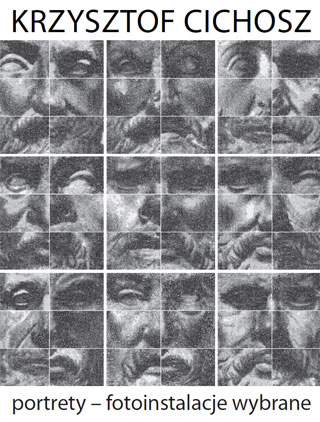

KATALOG
Photoinstallations are an open cycle of independent objects made by means
of the method I have been working on since the late 1980s. Each object consists
of many elements made of transparent photographic material, assemblied
in space in a few layers (three to five, most frequently four).
The projects are based on 'images-archetypes' originating from the iconosphere
that surrounds us: from manuals, encyclopaedias, newspapers, etc... The images
are subjected to a complicated process of constructive destruction in which
I decompose them by specially designed 'screens' (graphic structures) into many
elements made from transparent material. After assembling in space the elements
form large - 'almost' abstract - objects. The original images could be decoded only
if we found a suitably distant point of view - thanks to the synthetising ability of the
brain of someone who is looking at them...
Confronting the symbolic value of selected 'images-archetypes' with the
symbolic trait of the 'screens' that destruct them I try to encourage the audience
to follow my reflection concerning the world which surrounds us...
Krzysztof Cichosz
fotoreporta¿ ze spotkania
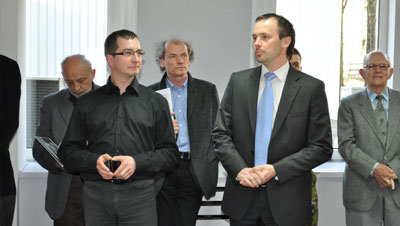
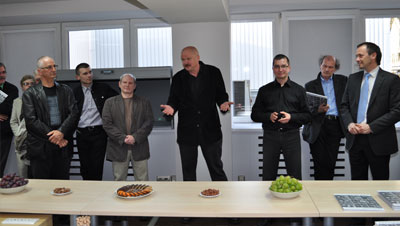
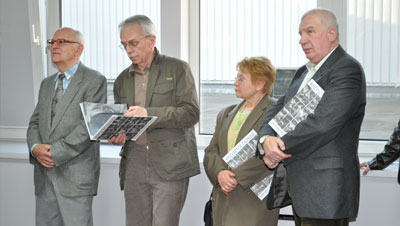

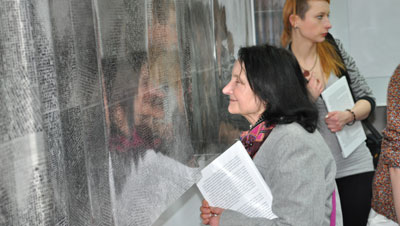
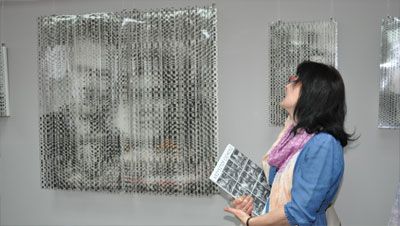
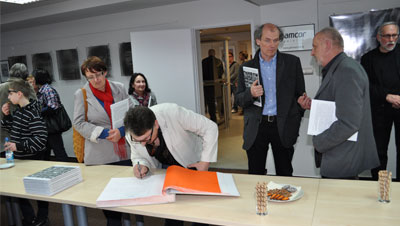
|
|
|
 |

















